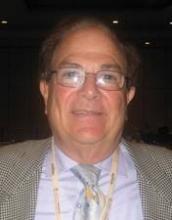LOS ANGELES – Occipital nerve stimulation provided relief from chronic migraine in a randomized, double-blind trial of patients who had not responded to currently available pharmacologic therapies.
The 12-week trial of 125 patients found that patients who received active neurostimulation were about four times more likely to rate their pain relief as excellent or fair than were those who received sham neurostimulation. The actively-stimulated patients also had more than double the reduction in number of days with headache each month.
"This is the first large-scale study of peripheral nerve stimulation for intractable chronic migraine that showed a significant reduction in pain, number of headache-days, and migraine-related disability," said lead investigator Dr. Stephen D. Silberstein of the Jefferson Headache Center in Philadelphia.
"These results suggest that patients who have exhausted all treatment options may benefit from peripheral nerve stimulation of the occipital nerves," he added. "These results provide the strongest evidence to date to support the safety and efficacy of peripheral nerve stimulation for intractable chronic migraine."
Session attendee Dr. Peter Goadsby of the University of California, San Francisco, questioned whether the trial was truly blinded, given the challenge of concealing group assignment when using neurostimulation. "It is very difficult. ... Much of the blinding in these studies is compromised," he said at the annual meeting of the American Headache Society. "I think it’s not fair to say this is the strongest evidence for peripheral nerve, occipital nerve stimulation. I think it’s another piece of evidence, but I don’t think that we have hit a home run here. ... I don’t think this is prime time yet."
"I’m not disagreeing with you," Dr. Silberstein replied. "I am saying of all the trials, in the subset of patients we defined as intractable chronic migraine, this is the best evidence so far. ... How do you blind brain stimulation trials? That’s a fundamental problem," he acknowledged, noting that patients in the trial were told that they were receiving neurostimulation with different parameters. "It’s very difficult and very complicated to control with any active stimulation device. We tried the best we could."
In the trial, the investigators enrolled patients with chronic, intractable migraines who had headache at least 15 days a month, had experienced a failure of at least three preventive medications, and had moderate headache-related disability. Their pain had to be at least 6 cm out of 10 cm on a visual analog scale and localized to the posterior head or originating from the cervical region.
Patients were not required to have responded previously to an occipital nerve block, Dr. Silberstein noted, explaining that "there is no evidence at all that occipital nerve block is predictive of the response to stimulation." Patients who overused medication were included, but those taking opioids were not.
All patients underwent implantation of St. Jude Medical’s neurostimulation system and were randomized to the neurostimulation group (n = 88) or the control group (n = 37).
Results showed that about 70% of patients in the neurostimulation group reported excellent or fair pain relief at 12 weeks, compared with only 20% of their counterparts in the control group (P = .001).
Patients who received active neurostimulation were also more likely to achieve a reduction in mean daily pain intensity on the visual analogue scale of 10%, 20%, or 30% (P less than .05 for each). "Looking at 40%, 50%, and 60% differences in this particular trial, they were not statistically significant differences, but again, remember, this was a disabling migraine population that had failed three therapies," Dr. Silberstein commented.
The neurostimulation group also had a greater mean reduction in monthly number of headache-days (7.0 vs. 2.7 days; P = .03) and were more likely to have a 10%, 20%, 30%, and 40% reduction in the number (P less than .05 for each).
In terms of headache-related disability, patients in the neurostimulation group also had a greater reduction in MIDAS (Migraine Disability Assessment) scores (a drop of 73 points vs. a drop of 27 points; P = .001) and in Zung Pain and Distress Scale scores (by 15 vs. 6 points, P = .001).
The overall rate of adverse events was about 61% in the neurostimulation group and 49% in the control group.
The leading hardware-related adverse event was lead migration, accounting for 15% of all events, with a higher rate in the neurostimulation group. "If you have a device in and it’s actively stimulating and you are getting pain relief, and then the pain relief ceases, it’s easier to identify the fact that you have had lead migration," Dr. Silberstein explained, adding that lead migration has become much less problematic as surgical techniques have improved.


